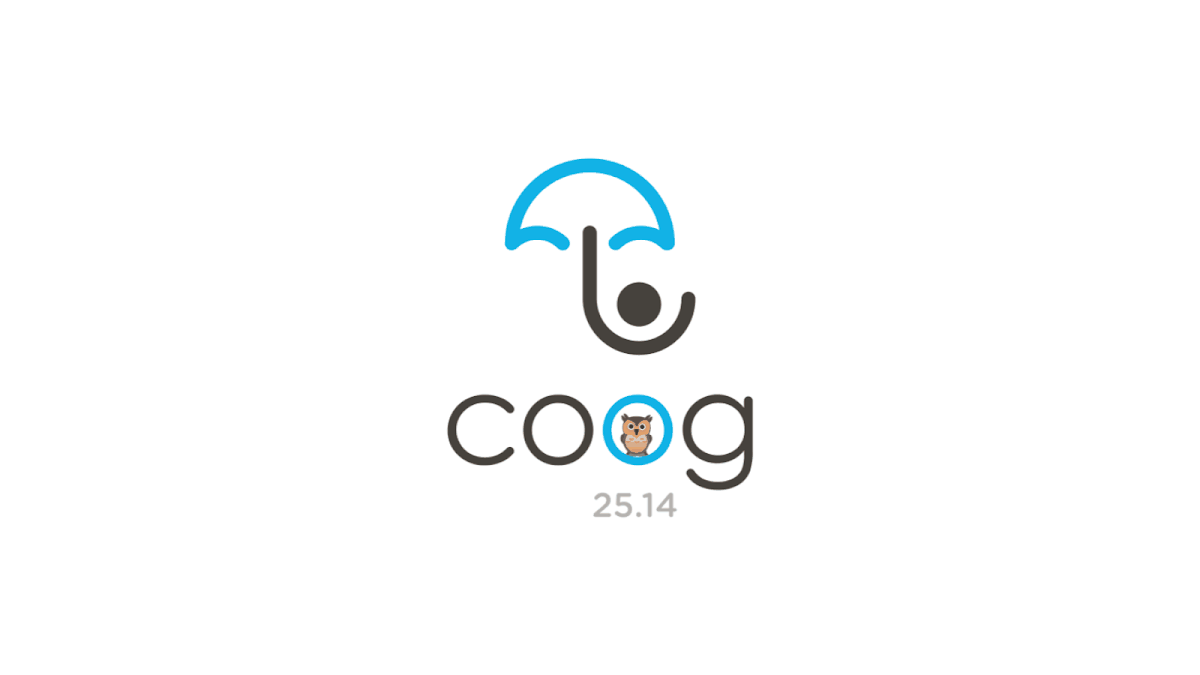 April 04, 2025 – Release notes
April 04, 2025 – Release notes
Two major coog advance topics delivered in this version 25.14: the fight against document fraud with the development of an API to interface with an anti-fraud expert, and the deepening of the RGPD module with an essential first technical workstream.
Not forgetting two other important new features, available as standard to all coog users: the implementation of taxation on death benefits in provident schemes, and the development of an interface with Docusign for the electronic signature of documents.
coog advance
Features reserved for contributors to the evolutive maintenance offer.
Combating document fraud
Development of an interface with an anti-fraud solution
Context: insurance companies need to analyze certain types of documents in order to combat fraud.
Evolution
To meet this need, coopengo chose to create a standard connector with CTMS, the anti-fraud expert for 25 years, to :
- Analyze the following document types
- Identity documents
- National identity card
- Passport
- Residence permit
- IBAN / bank details
- Examples: check that the IBAN for benefits has not already been registered with another identity, that it belongs to the person entered, etc.
- Proof of address
- Based on sample documents from major energy suppliers, telecom operators, etc.
- E.g.: proof of EDF or ENGIE subscription.
- Property tax, tax notice (2D-Doc “bar code” verification)
- Other crude documents (rent receipts, proof of accommodation, water supplier, etc.)
- Based on sample documents from major energy suppliers, telecom operators, etc.
- Identity documents
- Detect forgeries
- And enable insurance companies to investigate them.
Who is CTMS? Click here for more info
Regulatory
In-depth RGPD module
Context
This is the first technical step in the further development of the RGPD module at various levels.
In coog, intermediate archiving is based on the inactivation of third parties.
This implies two business requirements:
- Management of access authorizations for inactivated third parties
- Consideration of performance and technical architecture.
Final archiving is based on data anonymization.
This also implies :
- Optimization of anonymization rules, or even actual deletion
- Protecting health data contained in medical documents
Developments
Categorize data at field level and differentiate personal data from parameterization in order to:
- Make anonymization more reliable,
- Have client-by-client anonymization rules.
Use cases
Provide support and developers with databases containing customer production settings without personal data, thanks to a new extraction tool (see Data sampling tool in Technical core) to optimize processing of customer requests.
Example: correct an anomaly more quickly by extracting anonymized contract data from the administration menu.
Please note that this feature is currently only available for contracts. Tomorrow, it will be possible to extract anonymized data from a claim or a third party.
Addition of a batch to update the LCB-FT risks of all third parties.
Evolution: creation of a batch to check the existing population in the database.

This package is available for the standard interface with BeCLM or for any other partner.
coog Back-Office
Standard features available to all coog users.
Claims
Taxation of death benefits (Art. 990i and 757b)
Context: apply inheritance tax and/or the flat-rate withholding tax provided for in articles 757b and 990i of the French General Tax Code to death benefits.
Developments
- Creation of the two tax systems
- Delivery of standard rules for :
- Article 990i
- Calculation of deductions according to the amount of capital to be paid out
- Calculation of premiums paid after October 13, 1998 and before the insured’s 70th birthday
- Management of exemptions under article 990i of the General Tax Code
- Management of capital already taxed (inside and outside coog)
- Article 757b
- Management of requests for tax receipts
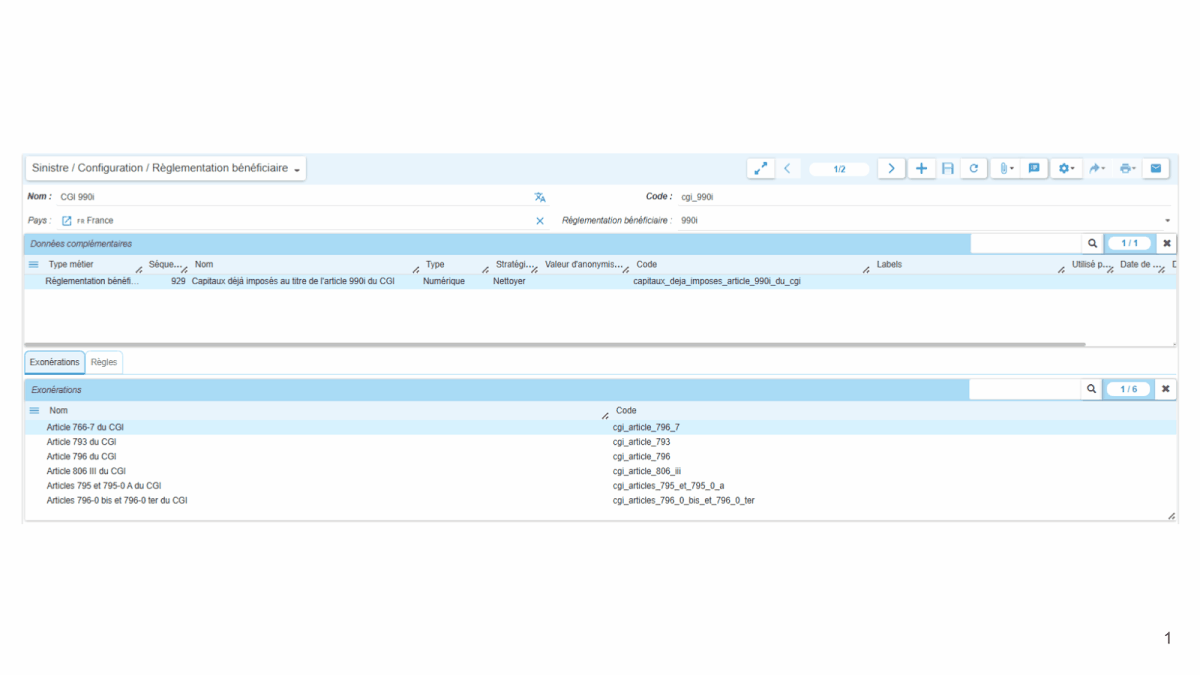
- Tax assessment for each beneficiary when seizing a death benefit
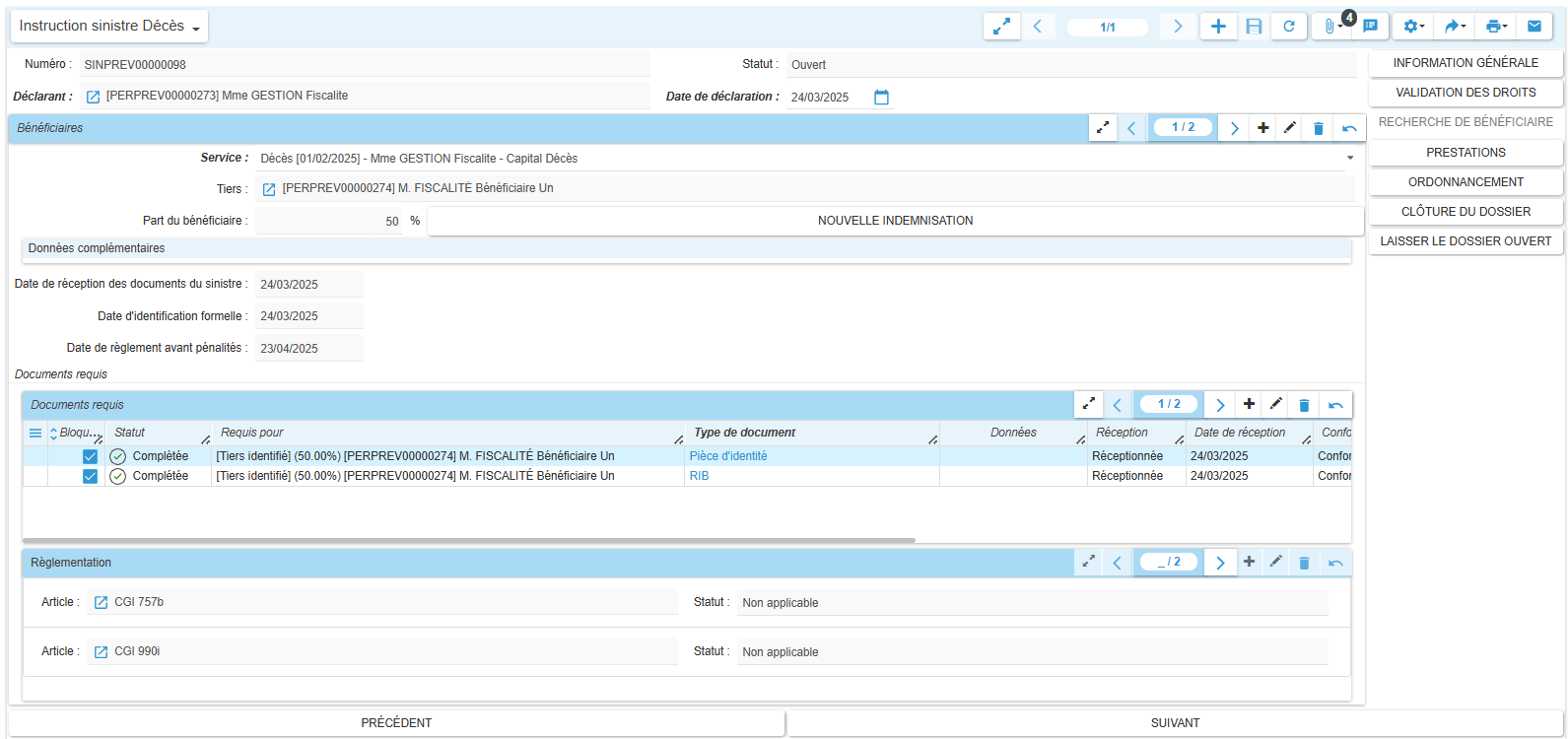
Enhancement of the “Change of benefits bank account” rider
Evolution: create a bank account directly via an IBAN from the “Change of benefits bank account” rider available on the third party.
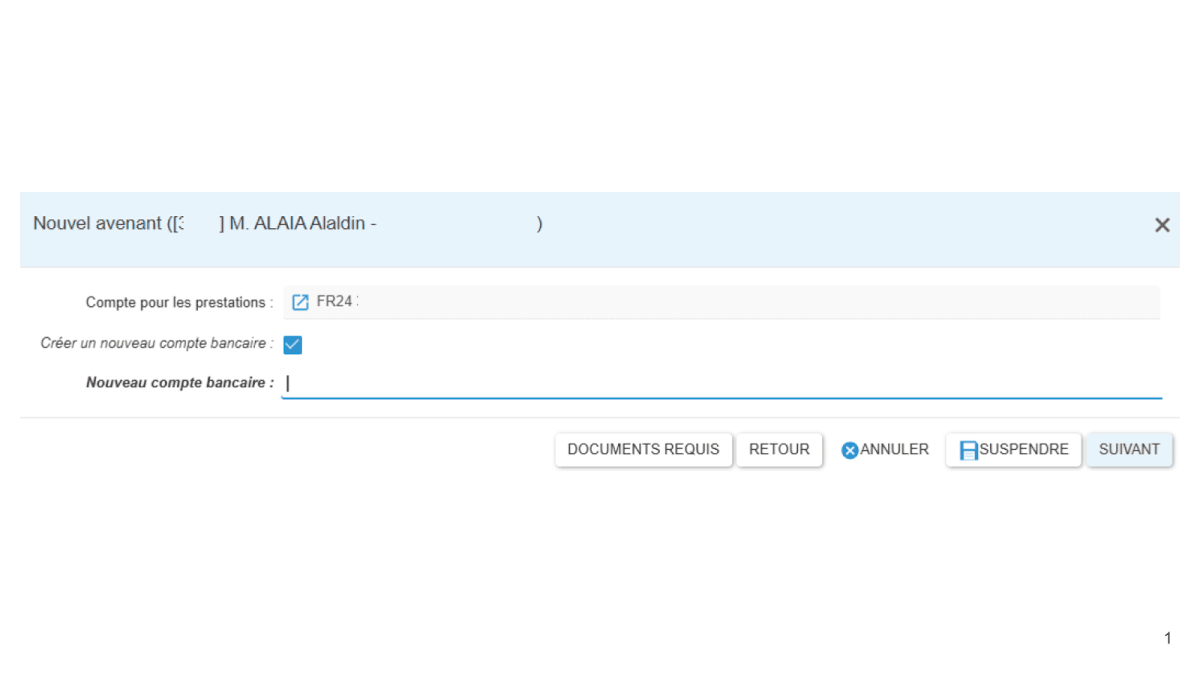
Improved ergonomics of the compensation calculation wizard
Enhancement: compensation details displayed directly in form view when there is only one beneficiary.
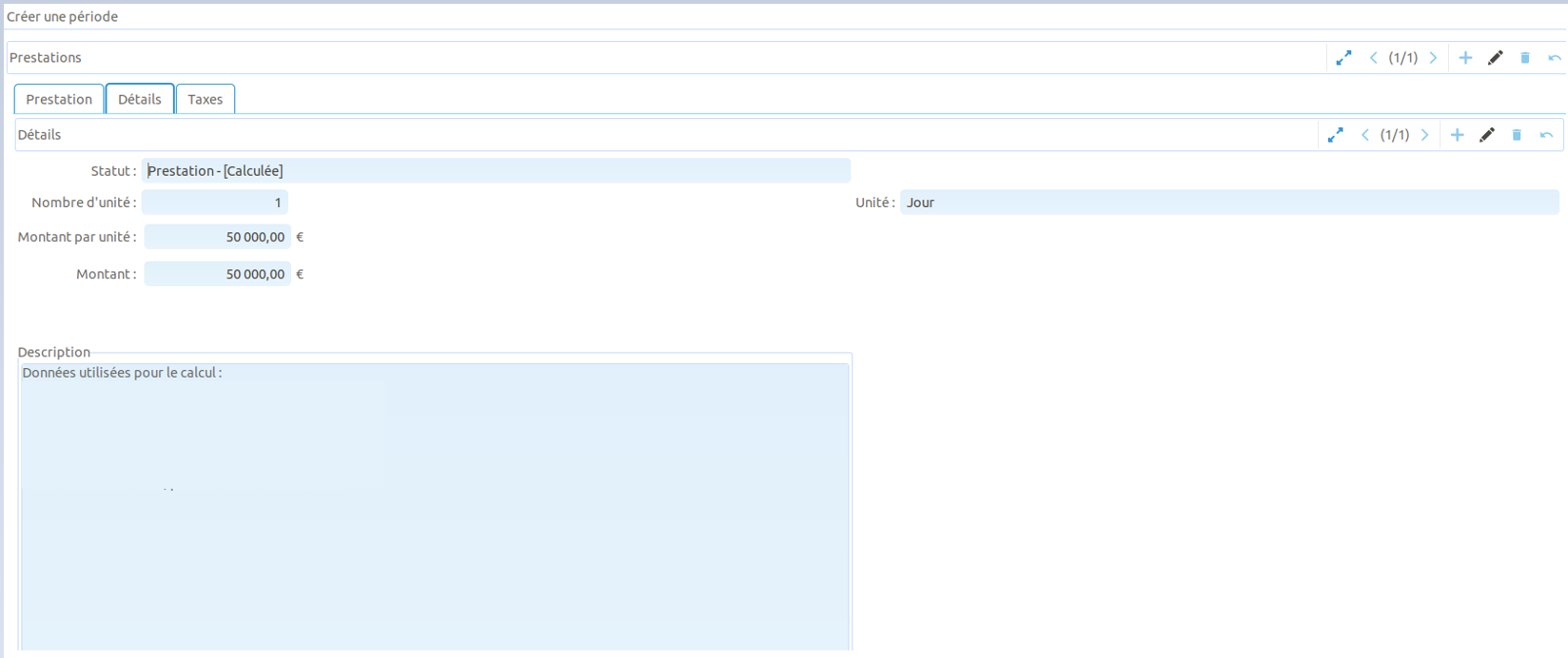
Example with a single beneficiary

Example with several beneficiaries
Automatic calculation of taxes on benefits
Business need: automate the choice of social security contributions to be deducted from benefits to be paid.
Example
ITT benefits are subject to social security contributions under PASRAU. The CSG rate to be applied will be automatically calculated by coog using a rule.
Evolution
Creation of the following objects:
- Tax situations,
- Field on third parties to feed the tax situation,
- Rules engine function to determine the taxes to be applied according to the tax situation on the third party,
- Rule on benefit settings to automatically calculate the contributions to be applied.
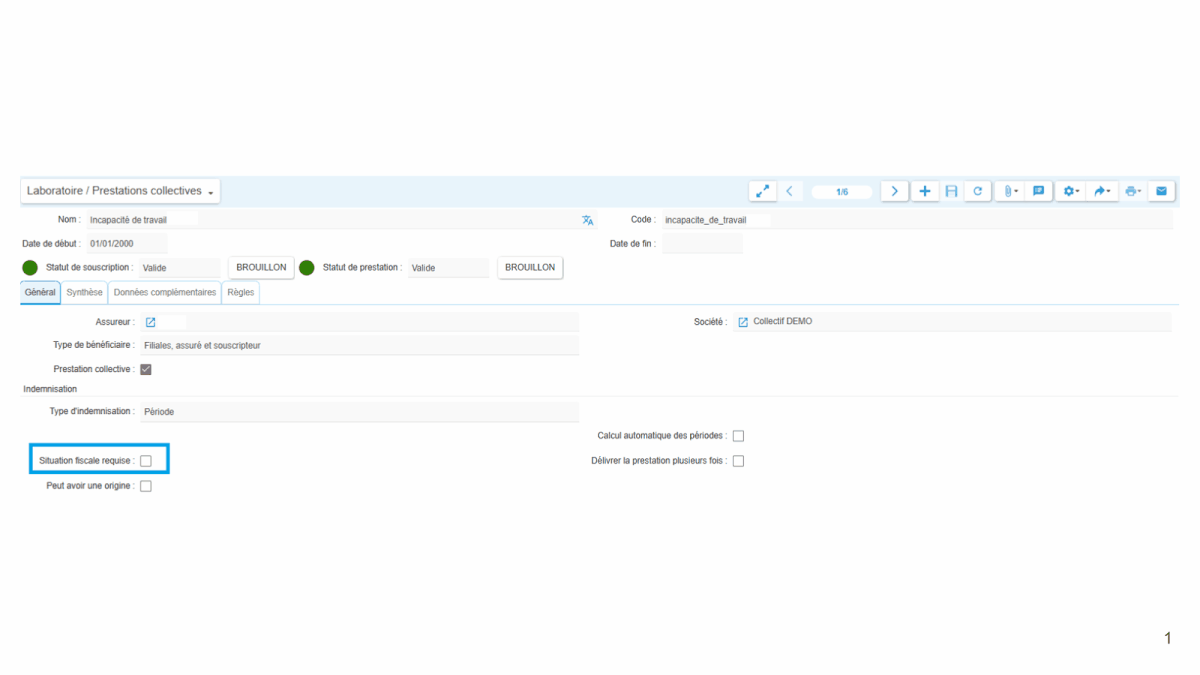
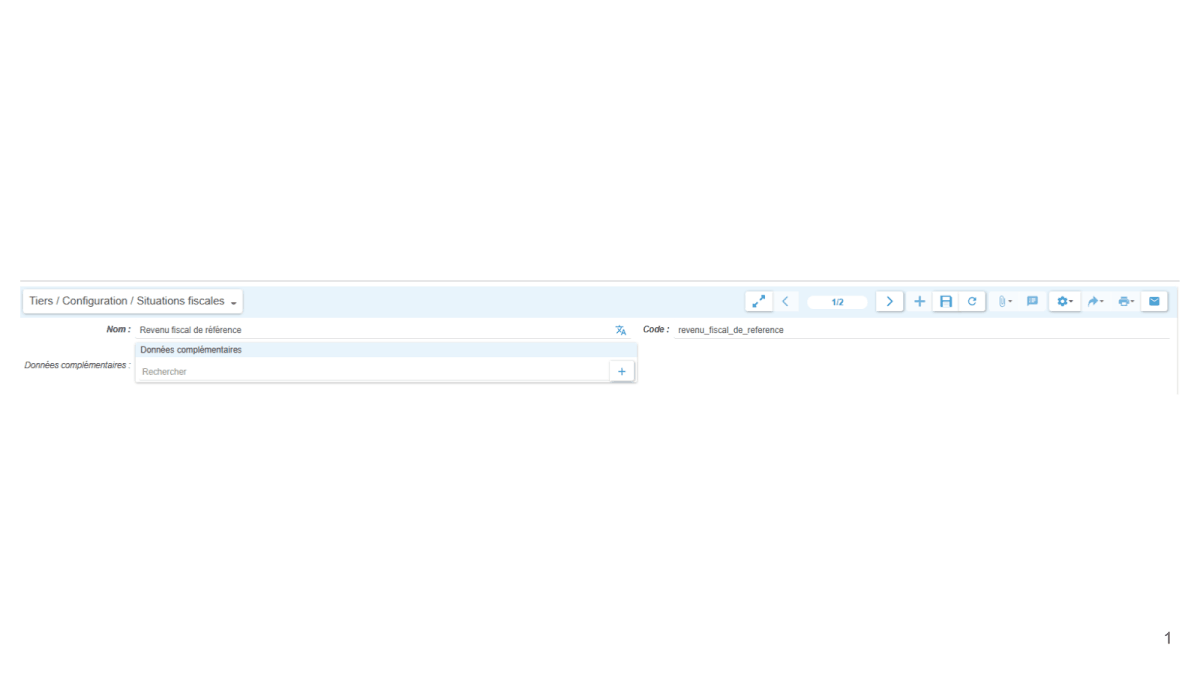
Managing benefit payments (due or to fall due)
Context: for certain benefits, particularly group benefits, it is necessary to be able to determine the frequency of benefit payments (due or to fall due).
Evolution
Addition of a benefit payment mode to the benefit parameters:
- For individual clients, the default value is “Due”,
- For groups, the value “To be selected on the contract” will be used to define the payment method when the contract is entered.
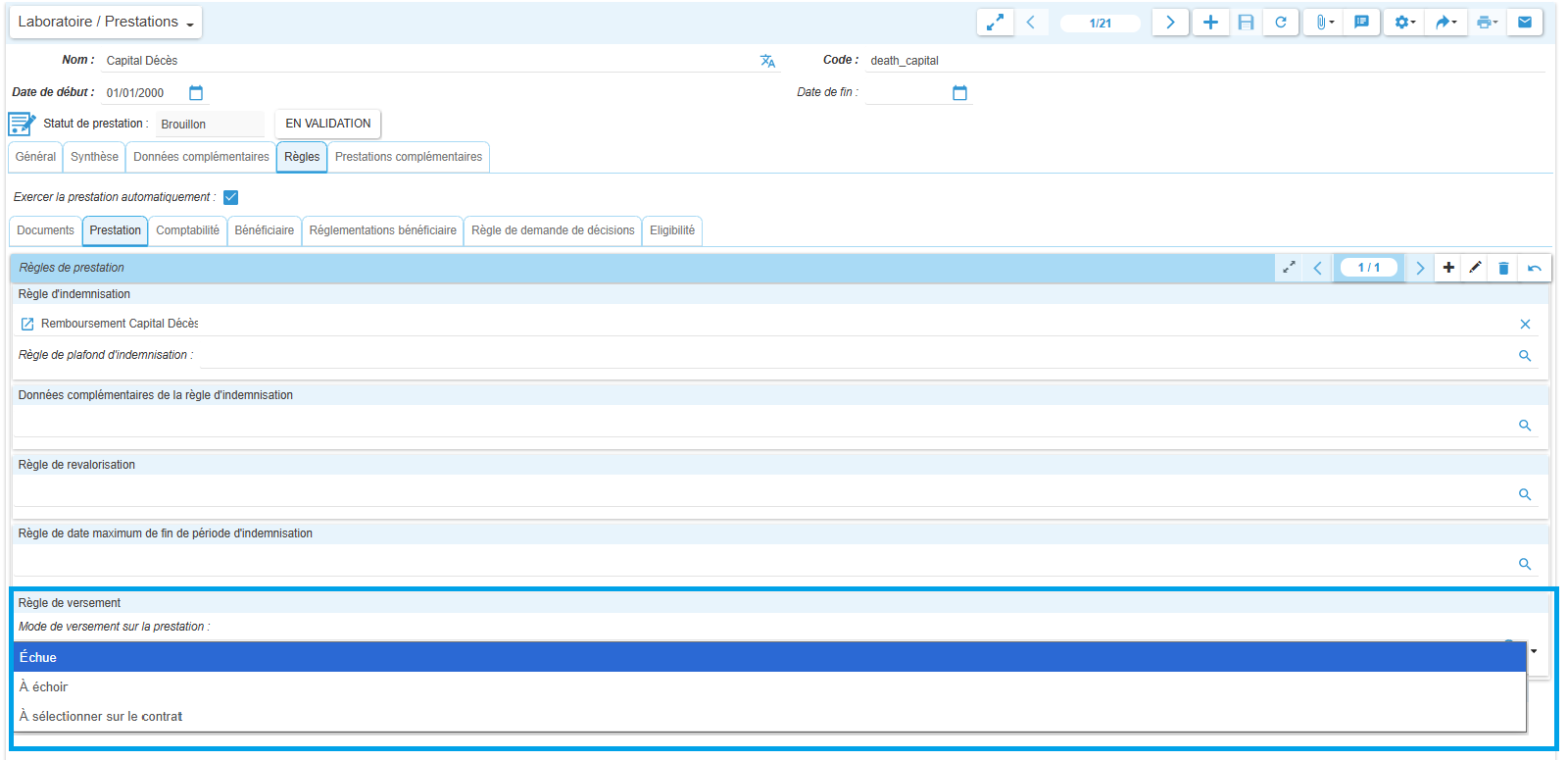
Addition of new functions in the rules engine that return total indemnities paid by “capital” type and “period”.
Evolutions:
- Creation of a “total_of_capital_on_this_claim” rules engine function, which returns the total of capital-type indemnities present on a claim,
- Creation of a “total_periods_on_this_claim” rule engine function, which returns the total number of period-type indemnities present on a claim.
Ajout d’un bouton “Nouvelle indemnisation” sur la vue formulaire des bénéficiaires
Évolutions :
- Ajout d’un “nœud” bénéficiaire dans la vue arborescente des dossiers sinistres,
- Ajout d’un bouton permettant de lancer l’assistant de saisie d’indemnisation dans la vue formulaire des bénéficiaires.
Addition of a “New compensation” button on the beneficiary form view
Enhancements:
- Addition of a beneficiary “node” in the tree view of claims files,
- Addition of a button to launch the compensation entry wizard in the beneficiary form view.
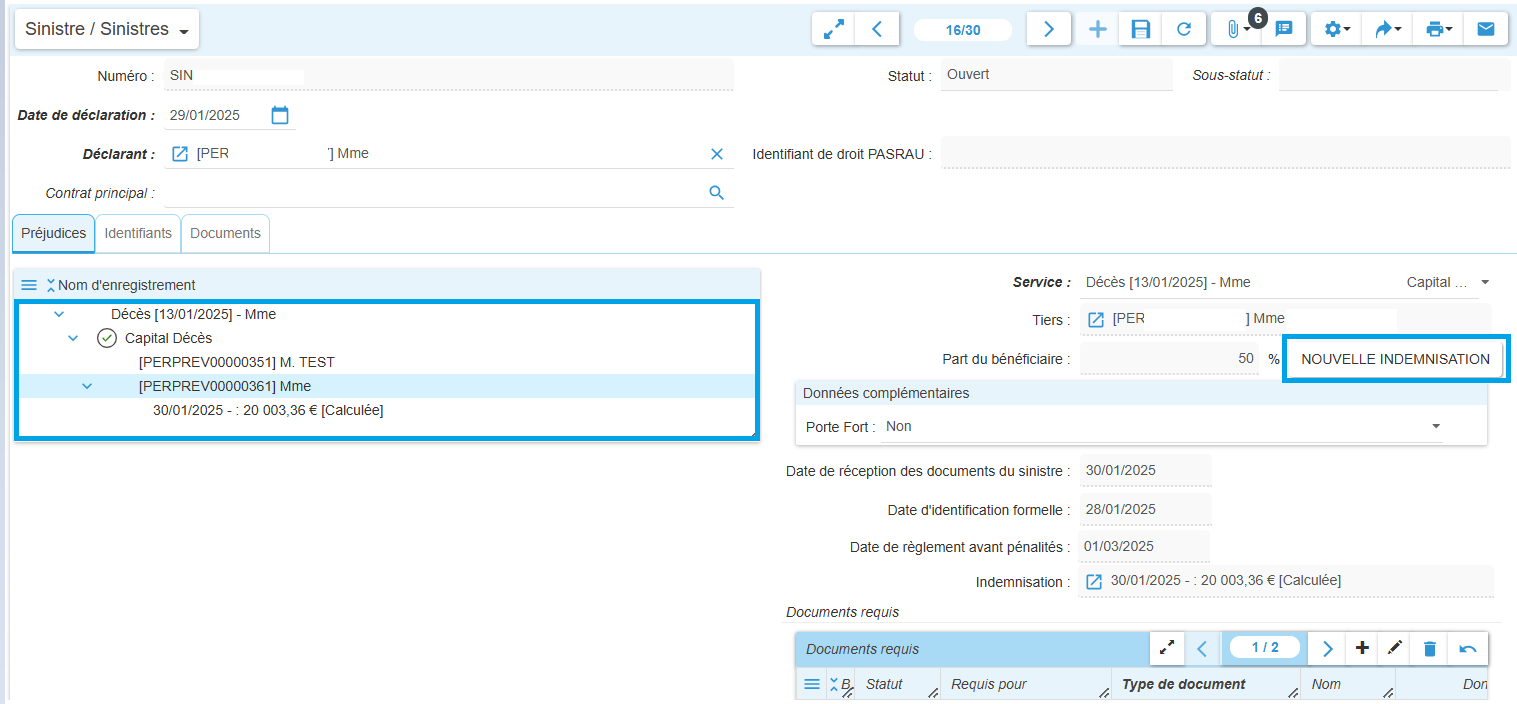
Requests for decisions can be revised after a claim has been reported.
Context: to be able to request a new medical analysis decision following an aggravation, for example, while retaining the initial decision for traceability purposes.
Evolution: a “New decision request” button has been added to the damage section.
Managing perishable claims documents
Context
Following on from the perishable document management functionality delivered in 23.41, perishable documents can now be applied to claims files.
Changes:
- Creation of an entry point for setting up dunning procedures,
- Creation of a new batch for generating document request letters.

Add additional data to requests for claims decisions
Context: in the context of medical decision requests for claims files, it may be necessary to manage additional data for the medical advisor (e.g. IPP rate).
Developments
- Creation of a new business type for additional data: decision request type.
- Addition of complementary data to the claims decision request management process.
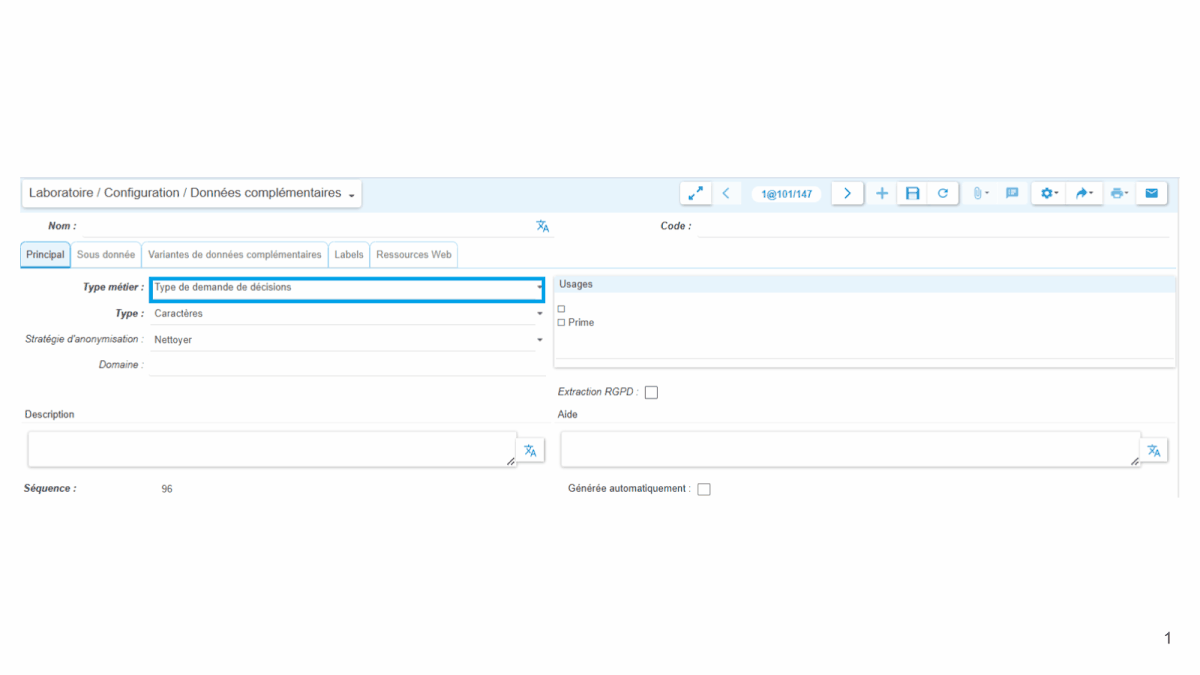
Addition of a function in the rules engine (reduction_value_contract)
Evolution: this function returns the total amount of the reduced value (reduction_value) of all active guarantees on the contract.

Documents
Electronic signature
Development of a standard interface with Docusign
Developments
- Creation of a “docusign_electronic_signature” module and management of authentication data via an integration key, a secret key and an RSA key pair
- Addition of a validation url generation button to enable coog access to Docusign
- Management of Docusign envelope generation for each document to be signed
- Consultation of signature request status
- Addition of a callback route to update signature status
- Possibility of manually updating signature status

Any other connector can be developed.
Desktop publishing
Add “Help” field to mail parameters form view
Evolution: to be able to parameterize help for users when entering mail parameters.
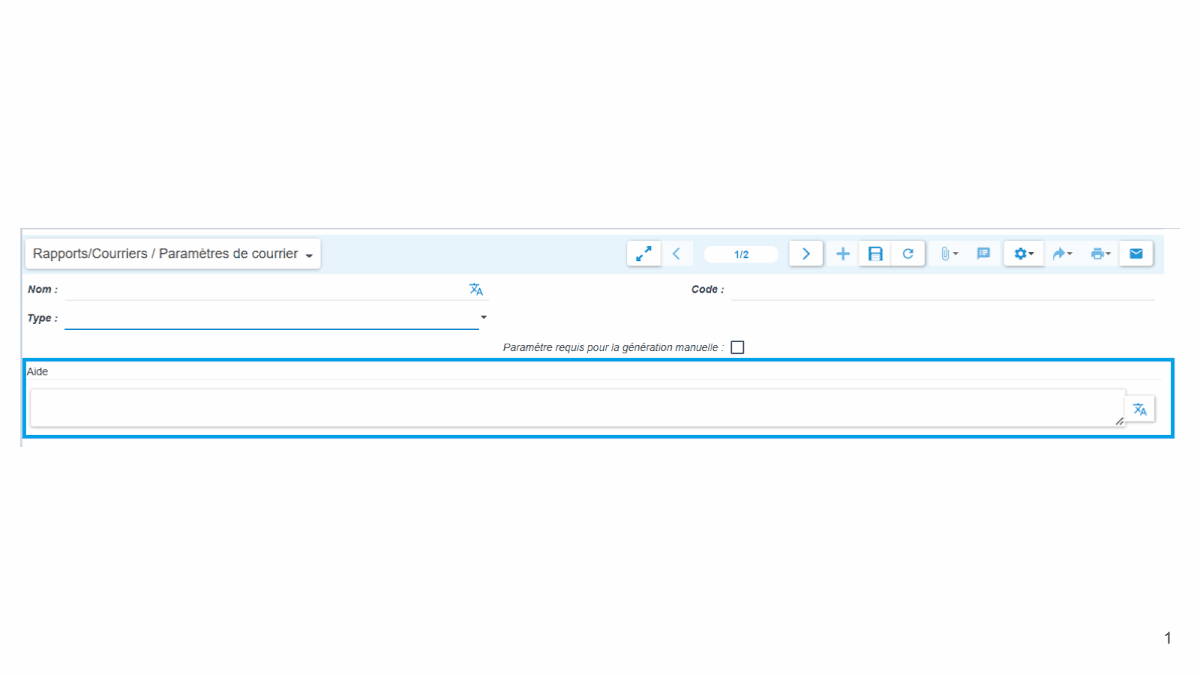
Generate a default generic Bdoc flow for contracts
Evolution: coog now provides a Bdoc-type XML flow for contract correspondence, presenting the main contract information for the provident insurance business.
Enhancement of the “get_future_invoices” function
Enhancement: a payment_amount column has been added to display the amount remaining to be paid on the lines to be paid.
Contracts
Automatic finalization of risk analyses on receipt of the last required document via API
Context: acceptance of surcharges by policyholders via API.
Evolution
When a risk analysis is subject to conditional approval, a blocking required document is created in coog (a document containing the new insurance proposal to be signed).
As soon as the document is received by API (via electronic signature, for example), acceptance is automatically recorded, along with the date on which the document was received, enabling the contract to be activated without the need for a manager’s intervention.
Automatic refund of overpayments on termination of a contract
Evolution
Implementation of an automatic refund mechanism for overpayments following termination or renunciation (without effect) of a contract registered with direct debit, thanks to the creation of a new batch (in the event of failure on a contract, a task is automatically created to allow manual refund of the overpayment).
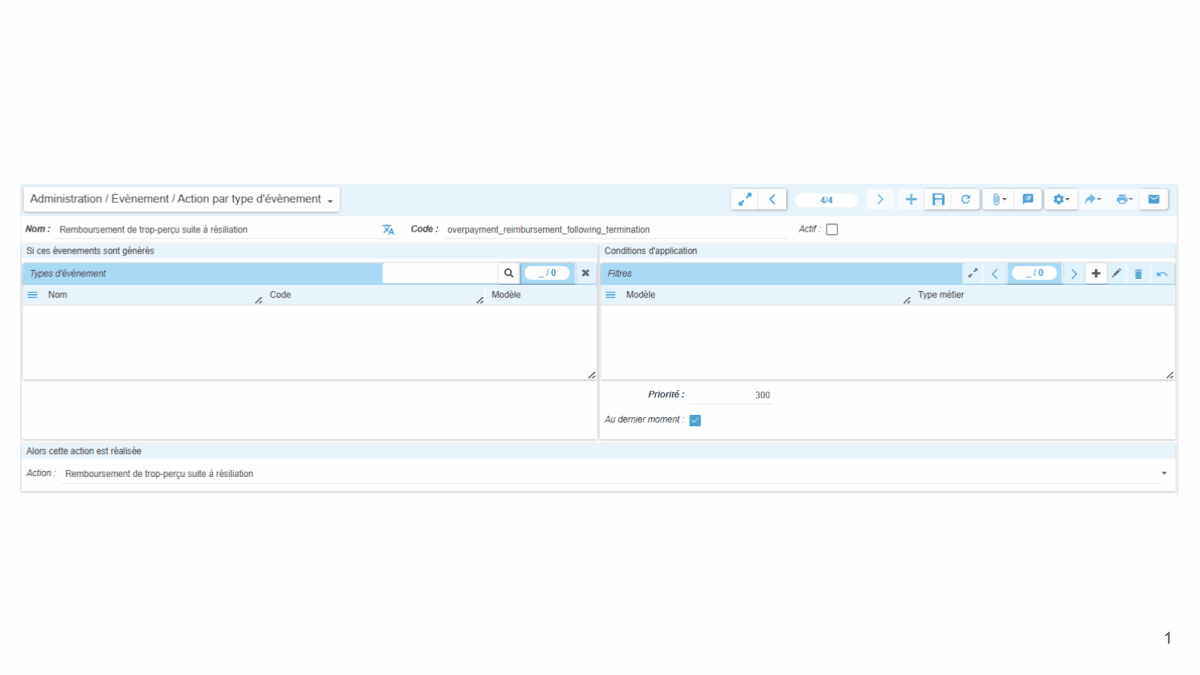
Addition of a button on the contract form view to enable manual generation of a Tiers Payant card
Evolution
Manually generate a TP card edition request without any rider. The TP card will be issued with the information currently held in coog.

Add free-month discounts to contracts
Context: in the context of certain promotional operations, it is necessary to offer free months when taking out a contract.
Evolution
In addition to commercial discounts in percentage or amount, it is now possible to set up free months. These reductions can be for a full month, or a percentage of the premium for X months.

Add a batch that automatically advances the contract subscription process
Context
When quotations are injected via API, they are sometimes blocked at the document request stage. Once the documents have been received, it is necessary for coog users to resume the quotes and advance them manually.
Evolution: creation of a batch that checks on each quote whether the status can be advanced without user intervention.

Initialization of the effective date of a rider when the chosen definition uses the “Frequency management” unitary rider.
Evolution: feed the rider effective date with the date of the day after the last paid receipt.
Management of excess premiums for catering
Developments
- On a benefit, it will be possible to set up a rule that returns the insured amount. This rule could, for example, simply return the content of an additional data item.
- On policies for which there is an insured amount rule, and only on this rule, it will be possible to enter an additional premium with the “Pourmillage sur montant assuré” calculation type.
- API: addition of the “Surcharge on sum insured” field in the GraphQL consultation of a policy.
Rules engine
Display of algorithm differences between rule versions.
Evolution
It is now possible to compare two versions of a rule.
- A green line represents the new version of the rule.
- A red line represents the old version of the rule.
- A blue line represents an addition.

Addition of a warning in the event of an error
Evolution: lines with a syntax or conversion error can now be identified more quickly.
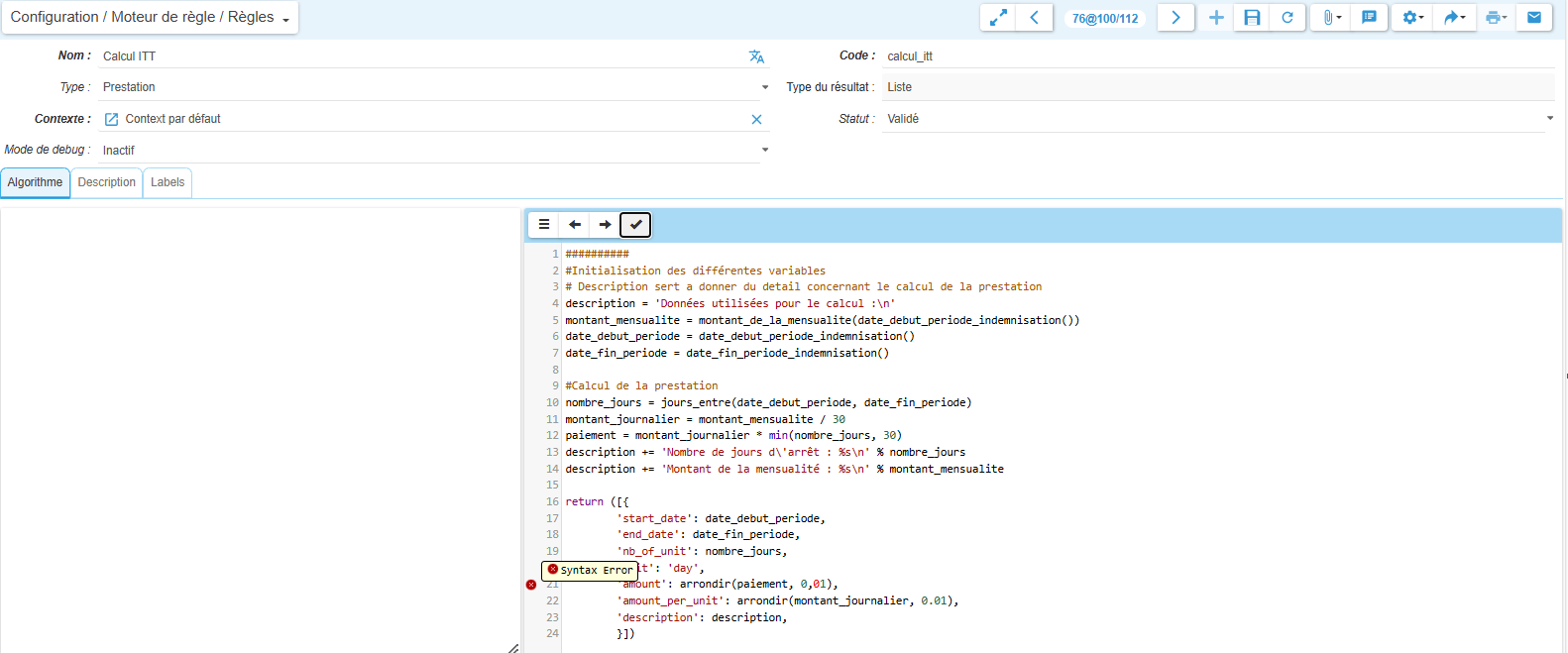
Technical core
Data sampling tool
Context: when analyzing and correcting anomalies, developers sometimes need to retrieve contextualized data that mimics the conditions of the error encountered by the customer.
Evolution
Creation of a wizard accessible only to administrator users:
- A data extraction wizard returning a coog-readable JSON containing the execution context and the data to be reinjected,
- A wizard for anonymizing the data,
- A wizard for inserting this data into your own configuration database.
Allow a batch chain to continue despite a failed batch
Evolution: added a parameter to allow the execution or not of batches following a failed batch in a chain.

Add a wizard to download batch execution logs
Context
Logs can be exported operation by operation. A batch with several operations requires the same action to be performed several times.
Evolution: added an action to download all functional logs for all batch operations.

Contributions
Add an automatic deleting batch
Context and use cases
Some business cases may generate a gap in the lettering:
- A direct debit on October 5 is indicated as successful.
- On November 1, the November 5, 2024 direct debit strip is sent.
- On November 5, the November 5 direct debit is reported as successful.
- On October 7, a debit rejection is received for the October 5 debit.
- The October receipt will therefore be unlettered, while the November receipt will be lettered.
Evolution
Creation of the “Automatic deleting of contract receipts” batch in the lettering chain, which will detect contracts with missing lettering. For each contract detected by this batch, processing will consist of de-lettering all the receipts following the first gap, then re-studying and repeating until there are no more gaps.
Re-lettering of contracts will be carried out by the next batch in the chain (existing batch “Automatic lettering of contract receipts”).
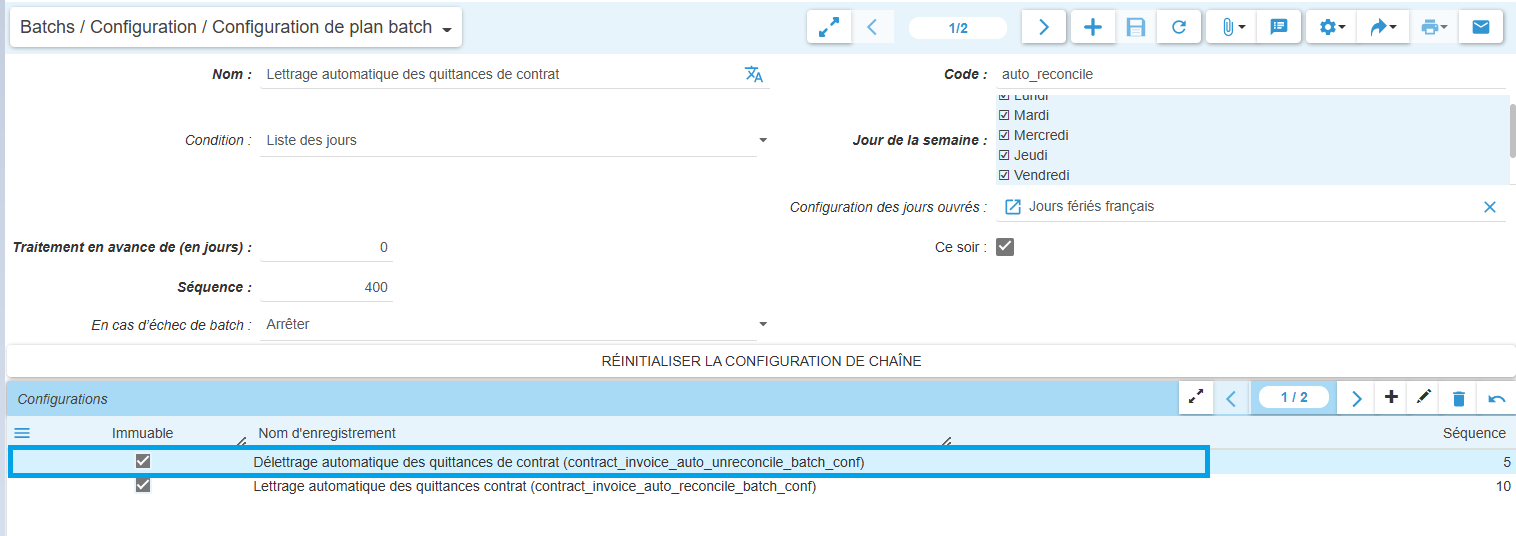
Commissions
New journal fields added to financial configuration
Context: differentiate the accounting journal to be used for broker commission slips and insurer commission slips.
Evolutions
Two new fields added to financial configuration:
- Accounting journal for insurer premium slips,
- Accounting journal for broker commission slips.

Migration
Add entry points for consulting migration cradle data
Context: facilitate analysis work on staging data during migration runs.
Evolution: addition of entry points for consulting migrated data. This entry point will contain all records migrated/to be migrated.
When a record is in error, a field lets you know why the record is in error; the record can then be modified to make the necessary correction.

Addition of new migration processes
Changes
Creation of new migration processes to take into account:
- Ancillary services,
- Root-covered elements,
- Contract-level risk analysis,
- Option exclusions,
- Beneficiaries on contract guarantees.
Updating existing migration processes
Developments
- SEPA mandates: default mandate status added.
- Contract: warranty formulas now supported.
- Commercial discounts: contract and guarantee discounts taken into account.
- Receipt lines: management of exemptions.
- Third party: country of death taken into account.
coog API
API for updating distribution networks
Evolution: updating the “block_payments” field to “Yes” no longer implies closing the commissioning protocol.
Update to the existing statement creation API
Context: Allows you to integrate statements from different journals.
Enhancements:
- Ability to identify the journal on which to create the statement.
- “Party” and “contract” objects can be identified using a “code/number” or an “id.”
Updated Contract View API
Developments
The API now allows you to retrieve:
- The category and family of a required document,
- The details of a contract’s risk analysis.
Creation of an API to view a document stored in an external tool in coog
Evolution
Creation of an API ecosystem to enable manipulation of documents stored in an external EDM in coog:
- Viewing API,
- API to integrate the document reference from the external EDM.
Attachments API: Create, retrieve, and download attachments.
Evolution
Creation of an API to manage attachments:
- Download,
- Update,
- Delete files.
Comments are closed.